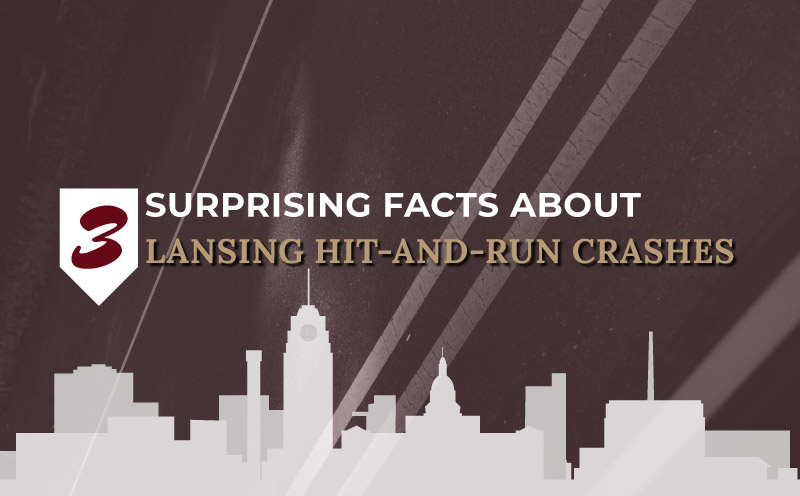Lansing Hit-and-Run Crashes – 3 Surprising Facts

Involvement in a serious hit-and-run accident is every responsible driver’s worst nightmare, especially when these types of crashes result in injuries. Unfortunately in Michigan, hit-and-runs accidents happen often. They occur for a host of reasons and result from a variety of influencing factors across the state. In this article, we explore Lansing hit-and-run crashes in hopes of raising awareness of their occurrence and educating people on how to better protect themselves from financial losses and other damages people often suffer in these types of automobile crashes. After researching relevant data, we discovered a few surprising factors regarding Lansing’s hit-and-run crashes.
1. Lansing hit-and-run crashes trending down – sort of
You’ll see that, for the last ten years, hit-and-runs in Lansing have been on the rise, only beginning to taper off over the last several years (with the exception of 2019). Readers will understandably wonder why these trends are happening. The year 2020 is the last full year’s worth of available data about Lansing car crashes – a year significantly impacted by the global coronavirus pandemic. With fewer drivers on the road that year, therefore resulting in a decreased risk of being involved in a hit-and-run accident, one can almost exclude the year 2020 from the overall trend in this dataset. Taking that factor into account, we look back at 2019 as the most recent year for compiling this trending data and see, shockingly, the most Lansing hit-and-run crashes actually occurred in 2019 for the last decade. Once MTCF releases 2021 data, it will be interesting to see whether or not the instance of Lansing hit–and-runs rose or fell last year.
Last 10 Years of Lansing Hit-and-Run Crashes
2. Most Lansing Hit-and-Run Crashes Happen in the Winter Months
Next, we wanted to see if there was a trend for Lansing hit-and-runs based on the time of year. As a state that swings significantly from season to season in its weather patterns, we hypothesized we might find a trend based on road conditions caused by weather. The results confirmed that.
For the last 10 years, 6,278 Lansing hit-and-run collisions occurred during the months of October – March; the six months most likely to see snow in the greater Lansing area. For the months of April – September for the last decade, 5,397 hit-and-runs occurred in the Lansing area. Therefore, drivers navigating Lansing roadways in the winter months were at a 16% increased likelihood of being in a hit-and-run crash.
3. Time of Day Significantly Impacts the Likelihood of Involvement in a Lansing Hit-and-Run
Hit-and-run collisions are often the result of the offending driver either (a) being in a hurry, (b) failing to abide by Michigan state laws, such as carrying a valid driver’s license or mandatory auto insurance, or (c) operating under the influence of alcohol or drugs. Because of these related factors, one can quickly find a pattern related to the time of day these auto collisions typically occur. While it was our initial assumption that we would see an increased trend in evening/nighttime hit-and-run crashes in Lansing, the actual results were shocking. The significant uptick in hit-and-run crashes in Lansing between the hours of 3 PM – 6 PM indicates that drivers on their evening commute are statistically most at risk of being involved in this type of collision.
While these statistics regarding Lansing hit-and-run crashes were somewhat surprising – with people driving during evening rush hour during the winter months most at risk – the data really shows that even the most responsible driver can be involved in a hit-and-run at any time.
So what can you do to protect yourself? And what do you need to know about hit-and-run crashes if you are involved in one?
How to Protect Yourself from Being in a Lansing Hit-and-Run
-
-
Purchase uninsured motorist coverage
Uninsured motorist coverage is far and away the best way to protect yourself from financial losses stemming from a hit-and-run crash. Financial losses caused by a negligent driver are often recoverable from the insurance company of that driver. In a hit-and-run situation, however, the negligent driver often cannot be identified, or is later identified and oftentimes has no insurance. Consequently, recovering damages from a hit-and-run driver is often difficult, or impossible.
Uninsured motorist insurance is a type of insurance coverage that you can add to your existing auto policy that allows you to recover from your own insurance company the uncollectable damages you have suffered as a result of an uninsured driver. Having this insurance can often make a critical difference in recovering financial losses and money damages for pain and suffering caused by a hit-and-run driver. We recommend that everyone speak with their auto insurance provider and price out the highest amount of uninsured motorist coverage you can afford for instances just like Lansing hit-and-run crashes.
To learn more about the types of damages that you can recover in a Lansing hit-and-run crash, click here
-
Seek medical treatment if needed.
If you sustained injuries in a Lansing hit-and-run crash, seek medical care immediately. Your auto no-fault insurance policy will reimburse you for medical bills related to your accident, up to the limit amount you purchased. If law enforcement eventually locates the other driver, you will need to pursue payment for any medical bills you accrue above and beyond your own policy limit through a negligence claim against the other driver. If law enforcement never finds the other driver, you will have to recover additional damages if you purchased an uninsured motorist policy before your involvement in the hit-and-run collision.
-
Get as many details about the other driver and vehicle as possible.
In a hit-and-run, you obviously won’t have the opportunity to pull over to safety and exchange information with the other driver. But in the moments following the collision, pay attention. Remembering the make, model, and color of the vehicle, what the driver looks like, and a license plate number will help police identify the offender.
-
Call the police.
It’s important to get law enforcement on the scene as quickly as possible when involved in a hit-and-run. Give them all of the information related to the collision so they can do their best to track down the offending driver. Learn more about Lansing traffic police reports here.
-
Speak with a Lansing hit-and-run attorney.
Contacting a skilled Michigan car accident lawyer with experience handling hit-and-run crashes is going to help you understand and protect your legal rights. An attorney experienced in handling these types of cases will be able to explore every insurance coverage option possible to make sure you get the best recovery for your losses.
-
If you were involved in a Lansing hit-and-run crash and need legal representation, call our experienced Lansing car accident lawyers today.

